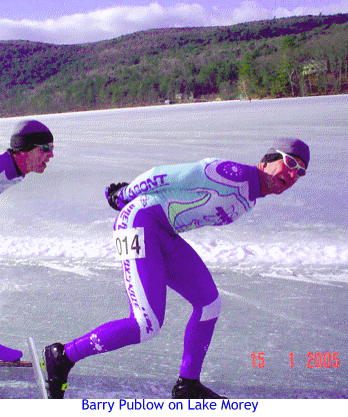 |  |  | |||||||||||||||||||||||||||||||||||||||||||||||||||||||||||||||||||||
| |||||||||||||||||||||||||||||||||||||||||||||||||||||||||||||||||||||||
Planet Interview with Barry Publow: Author and Coach Talks About His Return to Racing ... Also, His Plans for 2005, Going from Ice to Asphalt, and Common Mistakes Made by Skaters (Part 2 of 3) Robert: What kind of a setup (skates and frames) will you be skating on this year? Barry: I’ll be using the Bont Sniper 5 x 88 mm frame on custom Bont Vaypor boots. Robert: Some of your Breakaway Skate clinics are for inline skaters who want to learn to become competitive ice skaters. What does an inline skater have to learn to make the transition? Barry: In three words: balance, precision, and Inliners moving to the ice must go through several stages of development starting with the most basic of exercises. We always begin from the ice up, with skaters first developing a feel for the blade and how body weight distribution affects handling. Then we look at static position and gliding exercises, and then finally dynamic drills followed by a lot of tweaking. At this year’s Inline2Ice Transition Camp we had USA World Teammers Kimi Butler and Jilleanne Rookard. Both of these girls improved an incredible amount in just two shorts days. Robert: I'm confused about something. Some people say it is possible to use the double push stroke on ice. (They say that Chad Hedrick's is the proof of this.) Other people say the double push is impossible on ice skates. What do you think? Barry: Anyone who says it’s impossible to skate double push on the ice either doesn’t know how to skate or hasn’t seen one of several double push ice videos that have circulated the web. Double push on ice is very possible, but the range of its application is much smaller when compared to wheels. ... That is, less movement variation is possible, and a great deal of control and balance is required. Because of the rocker on a long-track (ice) blade (making it less maneuverable than wheels on the road), double push on ice can only be done at higher speeds. The real question with double push on ice is whether it offers the same advantage compared to skating on wheels. One of the issues with dp on the ice has to do with the location of body weight over the skate. With dp on wheels the body weight shifts to the far rear of the skate by the end of the underpush, then travels forward to the middle of the skate for the (regular) push. | Links: • Breakaway Skate web site | ||||||||||||||||||||||||||||||||||||||||||||||||||||||||||||||||||||||
... Copyright © 2006 by Robert Burnson | |||||||||||||||||||||||||||||||||||||||||||||||||||||||||||||||||||||||
On ice, the skater wants to shift the body weight forward as the push extends so that they can engage the clap blade and use the calf muscles. Shifting the body weight from the heel all the way to the toe on the blade is quite difficult, so in my opinion true double push on ice isn’t terribly practical under most conditions. However, I have been able to incorporate some slight double push range of motion into my ice skating and can utilize some of the mechanical benefits. This helps lengthen my glide and allow me to be more relaxed on the straights.
| |||||||||||||||||||||||||||||||||||||||||||||||||||||||||||||||||||||||
| |||||||||||||||||||||||||||||||||||||||||||||||||||||||||||||||||||||||

